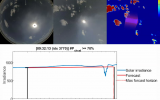Fisheye observes the Allgäu sky
There are supposed to be clouds over Wildpoldsried, too. In order to know if and when a cloud is likely to move in front of the sun, a so-called fisheye camera has been watching the sky for some time now. In contrast to normal cameras or surveillance cameras, this camera has a very curved lens and corresponding optics and can thus capture the entire sky hemisphere. The camera is mounted on one of the containers in the Energy Campus Wildpoldsried and provides a picture of the sky every 5 seconds. An image recognition process is used to evaluate and determine the shading of the sun for about 10 minutes in advance, in order to predict the power collapse of photovoltaic systems by clouds.
The aim is to include this information in the control of the system, for example, in time to start an additional generator or to curtail a PV early. Large power gradients in the grid are thereby avoided. This can optimize the dimensioning of electrical storage and thereby optimize the cost of such systems; similarly, contractual commitments to the behavior of microgrids at the grid point of common coupling are better met.
In addition to the camera, the method consists of an artificial neural network for the calculation of the probable cloud movements and thus the probability of covering the sun. Supplementary intelligence also takes into account phenomena such as cloud speed, the spontaneous appearance and disappearance, and other cloud specifics to make the prediction even more reliable.









